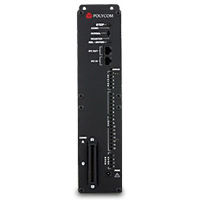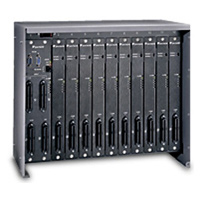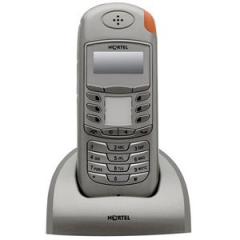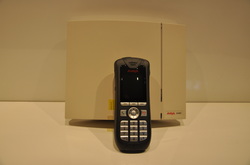Wireless System
Polycom® SpectraLink® 6100 MCU
The Polycom® SpectraLink® 6100 MCU is conveniently sized to support 16 wireless telephone users and four base stations. Four SpectraLink 6100 MCUs can be connected together by an inter-processor communication (IPC) cable to support as many as 64 users and 16 Base Stations.

The SpectraLink 6100 MCU is connected to the telephone switch or Centrex
lines by an RJ-21 connector and is powered by 24-volt DC through a 120-volt AC
adaptor. An administration mode allows you to easily add or remove wireless
telephones from the system, make changes to the MCU configuration, and download
software updates if necessary. LED lights on the front panel indicate the status
of lines and base stations. The SpectraLink 6100 MCU can be easily mounted in a
standard 19-inch equipment rack with the purchase of a separate rack mounting
kit.
Polycom® SpectraLink® 6300 MCU
Polycom® SpectraLink® 6300 MCU
The Polycom® SpectraLink® 6300 MCU is the processing center for large-scale
deployments. It consists of at least one primary shelf and up to 19 expansion
shelves and can support up to 3,200 users. The primary shelf contains the system
controller card that manages call processing for the wireless network. Telephone
line and base station connections are made to an interface module. Each module
supports 16 wireless telephones and six base stations, for up to 160 wireless
telephones and 60 base stations per shelf. Multiple sites can be networked using
T1 circuits between up to 18 remote shelves and the main
site.

Remote Networking
The SpectraLink 6300 MCU
supports up to 18 remotely networked shelves connected to a centralized System
Controller. A networked system allows users the ability to roam throughout
multiple buildings when the distance between the MCU and base station is farther
than 6,000 feet, or there is no way to effectively run the connecting
cable.
T1 circuits are used to provide the connection from the system
controller to each remote expansion shelf. A channel service unit (CSU) must be
provided by the customer at each end of the T1 circuits if the public-switched
network is utilized for the T1 connectivity. One full T1 circuit is required for
the first five interface module cards in a remote expansion shelf. A second full
T1 circuit is required if six or more Interface Module cards are deployed in the
remote expansion shelf. T1 Remote Modules are required to interface the T1
circuits to the SpectraLink 6300 MCU shelves. One T1 remote module is required
within the remote shelf and one needs to be placed in either the primary or an
expansion shelf at the local location. If a PBX is not utilized at the remote
site, the remote shelf is only required to connect and network the base stations
using interface modules. If a PBX is available at the remote location, a T1
circuit is still required for the remote shelf in order to fully network the
SpectraLink 6000 System.
Nortel T7406E Cordless Phone Handset

Frequency: 2.4 GHz
Supporting radio technologies: Spread Spectrum,
Frequency Hopping,
Antenna Diversity,
Multicast Signaling,
G729 Compression
Range: 1,000 feet (350 meters) clear line of sight as per independent lab
tests
Battery life: 5 hours speak, 36 hours standby
Dimensions: 138 mm height, 53 mm width, 53 mm depth
Handset features include handsfree/ speakerphone, vibrate/silent mode, 20
name directory, back light and message waiting options, signal strength
indicator and out-of-range audible alert
IP

DECT mobile devices deliver high-quality wireless voice communications to
employees who roam within a building or campus. They offer all the benefits of
the DECT standard, including high security, scalability, low power consumption,
and long talk/standby times.
The
DECT R4 suite (NAR, EMEA and select APAC countries) includes the 3725 handset at
the high end and 3720 at the low end. To simplify management, DECT R4 supports
remote configuration over the air or via cradle, 19 built-in user interface
languages, and options for both IP DECT and ISDN DECT radio base stations. User
productivity capabilities include SMS messaging, a Bluetooth headset interface,
and PBX features such as hold, conferencing and messaging.
The
IP DECT portfolio also offers the 3711 and 3701 handsets. The 3711 includes a
large display, easy-to-use menus, corporate directory integration and WAP
browsing. The entry-level 3701 provides basic telephony features, while
leveraging the power of DECT.




